| JAMES SHIRLEY'S TRIUMPH OF PEACE:
ANALYZING GREG'S NIGHTMARE
by
STEPHEN TABOR
| ||
DEVELOPMENT BY QUIRES
§4. Quire "a"
A. a1R (TITLE PAGE)
The four main states of the title page are shown in figure 1. A quick compari-
son
reveals that these states are largely in the same setting. Note, for instance,
the
damaged "M" in "Majesties", line 9, and the wrong-font final "3" in the
imprint
date, which is common to all states. It is relatively easy to demonstrate,
with a
purely typographic proof, that the order of states shown in figure 1 is also
the
order of printing. As mentioned in §1, the "O" in line 3 is sound (as
illustrated)
in some copies of state 1, but shows damage in others. Therefore, state
1 must
be the earliest. State 3 (a unique survival at the Folger), with its dangling
comma
after "Grayes-Inne", must precede state 4. One would assume that the
"third
impression" copies came last, and this is borne out by the association of
this state
with later states of quires A-D, as we shall see. If we play devil's
advocate and
posit an order of 1,3,4,2—moving the "third impression" forwards—we
would
not be able to explain why line 11 of the title ("February the third,
1633.") starts
in one setting in state 1, changes to another for
states 3 and 4, then reverts to the
original one in state 2. (The presence of a
comma or a period after "third" is the most obvious marker.) So, we can safely accept
the order as illustrated.
State 1 is further complicated by a deliberate realignment (state 1a2,
not
illustrated). Figure 1(A) shows the first word of the title sitting too far left
with
respect to the following line. During the printing of state 1, but after the
damage
to the "O" in line 3, the alignment was altered by shifting "THE" rightwards
so
that the "T" lay closer to the "V" below than to the "I". As a result, the
word
came to sit too far right on the page considered as a whole, but with respect
to
the following line, it is an improvement. No version of the title ever gets
each
line quite centered.

Table 6 shows the hierarchy of changes that we have just worked out. The
numbering
of the states refers to appendix 1. For the title, I have called the four
states 1a
(with three sub-variants), 1b, 1c1, and 1c2. The notation "1" recognizes
that all
are in the same basic setting and that the fourth is a stop-press variant
of the
third. The taxonomic key ignores other adjustments, even the resetting
of line 11,
that accompany the revisions signaled by the chosen markers. (A full
account of the
evolution of the ToP title page would provide enough material
for
a separate article.)
 |
The reason for the deletion of "of Grayes Inne" in state 1b, and its restoration
in
1c, is unclear. Shirley was admitted to honorary
membership in the Inn on 17Janu-
ary 1634. This was a common enough
practice for individuals who had rendered a
significant service, and it should not
have been controversial. Quite probably, Shirley
was led
to expect it as part of his compensation for writing the masque. He may have
allowed
the words to creep into the printer's copy in advance of the actual bestowal.
When
someone called attention to the error, the words were deleted, only to be re-
stored
(in a new setting, of course) in state 1c, which was evidently printed after
the
honor was official. Since there is no evidence that anyone tried to suppress
them in
earlier copies, the deletion could represent a minor adjustment for a minor
embar-
rassment. It could even have happened as a stop-press correction. This theory
would
have a corollary that the printing of at least state 1a was well underway or
completed
by the middle of January, and this would support Greg's assumption that
the pub-
lisher aimed to have copies ready for sale by the first performance of the
masque
on 3 February.
21
However,
the archival evidence and other facts I will adduce in
§16 argue against the book's
having been on sale that early. The disappearance and
reappearance of "of Grayes
Inne" is the first of many mysteries surrounding ToP that
I
will have to leave without a complete solution.
B. a2R
As with a1r, there was only one setting of this page. The following table shows
its
states along with those of the title page.

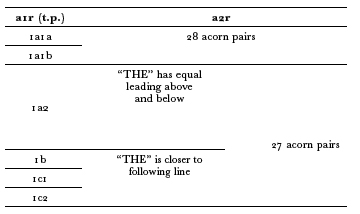 |
At the head of a2r is a decorative band composed of pairs of acorn orna-
ments. The
early state has 28 pairs of acorns, the later two have 27. It is nearly
impossible
to find individuality in acorn ornaments, but tiny differences show
that the change
results from resetting, not a loss of one pair on the end. The
reduction happens
simultaneously with a clear resetting of the direction line—
signature mark "a2" and the catchword—without a change of reading. There
being
no reason to reset the acorns and direction line in mid-run, it appears that
the
printing of a2r underwent a pause at this point during which the skeleton
(including
the acorns in this case) was replaced. Another arbitrary change oc-
curred later,
when the equal leading above and below line 5 of the heading (the
single word "THE")
was disturbed and that line drew closer to the one below.
The same operation
apparently dislodged a space two lines above, following the
words "Equall and", so
that copies printed thereafter show a gradual rightward
drift of those two
words.
C.a2v
Like the others in quire "a", this page has only one major setting (see table 8).
The first change to a2v is the stop-press correction of "ond" to "and". (The
error
was a simple one for either the typesetter or the previous distributor to
make—the
"o" box in the typecase lay just above the "a".) All copies of the un-
corrected
state also have the undamaged "O" on the title page (a1r:1a1a). After
the correction
to "and", further copies were printed before the "O" on the title
became damaged
(initiating state a1r:1a1b). The addition of the comma after
"Honourers" on a2v
occurs at the same point as the re-alignment of the first line
of the title page
(producing a1r:1a2). The copies with the "Third impression"
title page (starting at
a1r:1c) also show a resetting of the closing two lines of the
dedication on a2v,
with no difference in reading. This sort of arbitrary change
should remind us of the
headline resettings that, as I have argued, signal pauses

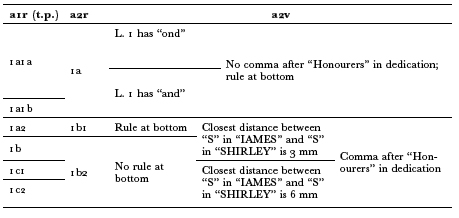 |
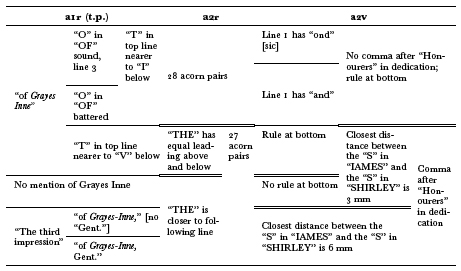 |
such indicator; it coincides with the disappearance of "of Grayes Inne" on the
title (a1r:1b). Shirley's signature to the dedication and the rule below it seem to
operate as part of a quasi-skeleton that is less stable than the text on which it borders.

D. QUIRE "a" ENCOMPASSED
Let us now combine in one sweep of the eye the states of the three
type-pages
comprising quire "a". Table 9 is a "plain English" version; table 10
shows the
variants using the shorthand keyed to appendix 1. In both tables I have
provi-
sionally placed double lines at the points of possible reimposition that I
have
discussed above, which seem to indicate breaks in the printing.
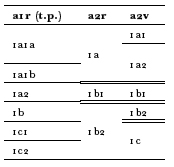 |
Note that the changes on all three pages tend to occur in lockstep. Quire
"a" is a
half-sheet, which would most economically be produced by half-sheet
imposition run
off by work-and-turn.
22
In this method,
all the pages of the quire
are printed at once, and the sheets are flipped
end-to-end and perfected with the
same pages on the back. When cut in half, each
sheet yields two copies of the
quire. If this were the case with ToP, and if one examined the type impression
in many copies, about half will
show that a2 recto was printed before the verso,
while the other half will show the
opposite sequence. I have attempted this exami-
nation on 23 copies of ToP—a difficult process because the outer leaves normally
show
most of the soiling and were usually washed and pressed at some point.
Only leaf a2
can be analyzed in this way because the title leaf verso is blank.
But the test did
show a mixture of sequences of printing, so we can be confident that
quire "a" was
printed by work-and-turn.
Because Norton used half-sheet imposition, all three type-pages of quire "a"
were
accessible to alteration at the same time. So, it is not remarkable to see
changes
taking place across all three pages simultaneously. The thing to note
at these
transitional points is the mixture of arbitrary revisions with apparently
rational
ones. When the number of acorn pairs drops from 28 to 27, the title
page gets a
small realignment and the comma is added on a2v. Later, when "of
Grayes-Inne" is
removed from the title (state a1r:1b), the rule disappears from
under the dedication
on a2v and the line spacing changes on a2r; the latter is
an apparently random
disturbance that entails the accidental loosening of a line.
The addition of "The
third impression" to the title (state 1c) brings with it some

lier suspicion that the printing of the preliminaries proceeded in several discrete
spurts of work, of which the double-rule boundaries I drew in the tables above
mark only the most obvious transitions. I believe we have good evidence of four
printings, and that the double-rule segments in tables 9–10, indicating pauses in
the work, should run straight across both formes. I will refer to these printings,
or discrete periods of work on the formes, as "phases", and table 11 incorporates
them into a comprehensive scheme for quire "a":
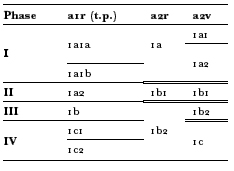 |
My accounts of quires A-D will be less detailed than the foregoing and will
ask the
reader to refer to the taxonomic key of appendix 1.
§5. Quire A
Table 12 results from mentally removing quire A from every copy of ToP
and arranging its pages in order from early to late states. Heavy
horizontal cell
borders indicate complete resettings; double-rule borders show
reset headlines
indicating reimpositions of standing type. Again the printing
seems to divide into
several phases. The table shows that the formes evolve in the
same direction,
which indicates that the printer was executing an orderly flip of
the stack after
printing the first forme: the first-printed sheets of one forme
became the first-
printed of the other. This pattern generally holds throughout
ToP, though we will
find some aberrations in the other
quires.
The table reveals that, as with the preliminary quire, Norton turned out sheet
A
in several discrete phases of work. The most common marker of a shift to a
new
phase is the resetting of the skeleton, or extensive text, of multiple pages
at
the same points in the production history, though quire A does not show
this
consistently. As mentioned in the previous section, it is often impossible to
say
what motivated Norton to distribute some pages and not others. In the case
of
quire A, all but one of the pages (A1v) retain at least half of their original
settings
throughout the printing history. A1v was reset after Phase I, and the
bottom half
of A2r was reset twice. Work on Phase II of quire A—the most clear-cut
transi-
tion point in the quire's evolution—began by reimposing all of the
outer-forme
type-pages set for the first phase. (Analysis of the type bite shows
that quires A–D

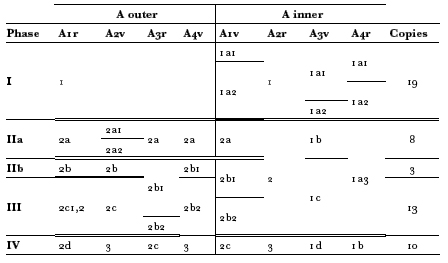 |
Norton reimposed the inner forme using two pages with minor changes from
Phase I (A3v and A4r, which lay head-to-head), but the other two pages of the
forme were either completely or partly reset (A1v and A2r respectively).
Other phase shifts were more subtle, and the transition from IIb to III
was
barely a whisper: only two pages got stripped and a couple of raised quads
were
pushed down on a third. The backing forme shows no sign of a
corresponding
interruption. This lack of correlation requires some fancy
explaining. My feeling
is that the reimpositions on A1r and 2v, though they affect
only two pages out of
eight in the quire, were still associated with a work
stoppage. The lowering of the
quads on A4v, which happens at the same time, was
probably an unintentional
result of removing the type-page at the end of Phase IIb
and replacing it for
Phase III. Furthermore, on the evidence of the surviving
copies of ToP, the number
of quire-A sheets in Phases IIa
and IIb combined (11) is approximately equal to the number of sheets of the other text
quires in their own undivided Phase II
(quire B, 10; C, 10; D, 11). Copies of the
book that contain Phase III
of sheets B-D also contain Phase III of sheet A. (One
exceptional copy from Phase III (Folger STC 22459.2) has an A-sheet from IIb, which
indicates a possible slight
overrun of the A sheets that found their way into the
following phase. I discuss
the overrun in more detail in §13.) These are the
reasons I have designated the
two sub-phases within the second impression of quire
A.
It is likely that Norton's original intent was to print Phase II as a
continuous
job, but that something interrupted the machining of the outer forme
and the
type was removed from the press. This marked the end of Phase IIa. When
he
was able to resume work, he had two options. The simpler was to put the outer

perfect the sheets from Phases IIa-b of the outer forme together. However, a
skeleton resetting on A1v and a page-number shift on A3v in the inner forme
suggests that the perfecting of IIa-b also proceeded in two phases of work. Norton
perfected all the IIa sheets before doing another printing of both formes to
complete Phase II. Although it required more shifting of formes, this tactic would
prioritize the completion of some number of finished A-sheets. This would allow
a more speedy assembly of at least some copies of the whole book.
The inner forme of Phase IIb is indistinguishable from that of Phase III
except
for a stop-press correction which appears part-way through the latter
phase
(A1v:2b2). On the evidence of table 12, Norton could even have printed the
inner
forme of Phase IIb and continued straight on to print the inner forme of
Phase
III in the same run, perfecting the sheets of the latter phase with the
outer forme.
But the type-impressions show that Norton always printed his outer
formes first. So, we have to conclude that Norton began Phase III of quire A with only
minor
changes to the outer forme (new skeletons for A1r and A2v) and none at
all
to the inner. The boundary line between Phases IIb and III continues
invisibly
right across the inner forme. We will later see similar arbitrary
patterns in the
production of the other sheets.
A few other observations on quire A are worth making:
- In the outer forme, the four pairs of variants A1r:2c1–2,
A2v:2a1–2, A3r:2b1–2, and A4v:2b1–2 all involve printing accidents. The last two pairs
result from specific, one-time events. On A3r, the "3" in the signature mark
drops out in the second state. (This may have occurred during the act of repairing
some type damage and mis-alignment at the upper left, shown uniquely in copy
bL 644.0.44. 23 ) A4v:2b1 has the quads printing between the two paragraphs, as
mentioned above; these rose during the reimposition preceding Phase IIb and
disappeared again at the inception of Phase III. (The rule below the text shows
various bends during these changes.) In contrast, the "variant" on A2v involves
a progressive downward creep of the last letter of the catchword, so these are not
two distinct states. Similarly, the A1r variants involve a page number that prints
more or less faintly—evidently a function of variable depths of impression—and there is no clear progression one way or the other over the course of printing. All
these changes present a random picture in appendix 2, but if one plucks out only
Phases II and III of quire A and puts the rows in order by state, the progression
becomes clear. - In A1v:2b1, the jockey in the torchlight parade holds a "bride" in
his
hand; state 2b2 corrects this to "bridle". Previous attempts at ordering ToP (most
recently in the STC) have tried to use this difference to characterize major groupings
of whole copies, but we see here that it is simply a stop-press variant within
Phase III. - Copies of the book with sheets from Phase IV of quire A come only with
a
"third impression" title page, and vice versa. In this final phase, a paragraph of description
added to A2r affects the page breaks for the rest of the quire. Sometimes135the transferred text was moved in type, sometimes it was reset. The method used
depended largely on whether the lines travelled to a facing page (i.e. in the same
forme) or to the verso (printed in the next forme, in which case the transferred
text was usually reset). Section 15A gives the specifics of this process. - Between Phases I and IIa, the four lines of italic split between A2v-3r
were
raided and reset in great primer size (120 mm). - In Phase IIb, the catchword on A2v, which heretofore correctly
read
"The", changes incorrectly to "All". This marries with the first word in roman
type on the next page, but ignores the two lines of italic that precede it. We would
expect this sort of error to arise during the italic raid after Phase I, but that had
already occurred. Instead, it appears that the workman doing the reimposition
for Phase IIb did not notice the italic lines and took his cue from the first paragraph
in roman. The error persists through Phase III.
To complicate the situation
further, that leaf was removed from the British Library
copy by Thomas Wise
and used to make up the Wrenn copy, now at the University of Texas.
§6. Quire B
A. PHASE I
The early phase of quire B presents one significant difficulty:
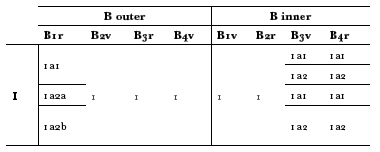 |
Only three pages show variant states in this phase. Those on B1r are:
1a1 heading wholly in italic
1a2 heading reset with characters' names in roman
- type relatively undamaged
- first letters of ll. 7 up and 9 up are damaged
We can be reasonably certain that this is the correct order because the
type
damage does not occur during state 1a1, and the reset heading follows the
normal
convention by giving proper names in a contrasting type style.
The variants in B3v-4r, in the backing forme, involve commas.
24
Neither
state is obviously the earlier, but the
direction of the change is less interesting at
this point than its confused
relationship with the outer forme: the early and late

distribution of surviving copies is as shown below:
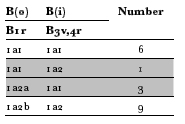 |
If, after printing the outer forme, the printer followed a normal turn of
the
heap of sheets that contained B1r, we would expect the changes on B3v-4r, in
the
backing forme, also to follow an orderly progression from early to late. We
saw
this pattern in quire A. In contrast, the distribution of states in Phase I of
quire
B shows a sort of "countercurrent eddy", indicated by the shaded cells
above.
It appears that a disorderly stack-turn took place. To understand this
concept,
first recall that a normal print run of a forme might produce several
hundred
sheets, yielding a thick pile of damp paper with the last-printed sheets
on top.
To preserve the same order and orientation of sheets going through the
press
on the perfecting run, the pile had to be inverted end-to-end. Since the
pile was
too bulky to turn as a unit, the workman had to transfer it in several
handfuls,
inverting each one onto the new stack.
Suppose instead that the workman carelessly transferred one handful of
sheets
straight across without turning it. This would produce a stratum of sheets
with
the printing facing the wrong way. We would expect the pressman, when
working
down the pile and finding this mistake, to utter a curse, turn the
affected sheets
to align with the others, and go on working. But he might also
utter a curse and
start picking up the sheets from the opposite end, using a
slightly different motion
to place them on the tympan. The pinholes—normally
positioned slightly
asymmetrically—would help prevent mishaps in perfecting, and
the pressman
might enjoy the little bit of variety until reaching the underlying
layer of correctly
oriented sheets. This seems to be what happened in Phase I of
quire B. Let us
use our sample of the nineteen copies of that phase to stand for
the entire first
printing of this gathering. The machining of the outer forme
(containing B1r)
produced a heap like the one on the left below, with the later
states on top.
If we now back up these partially garbled sheets with the inner forme
containing
B3v-4r, which begins with state 1a1 and switches to state 1a2 about
half-way
through, we get the observed distribution of variants (table 15).

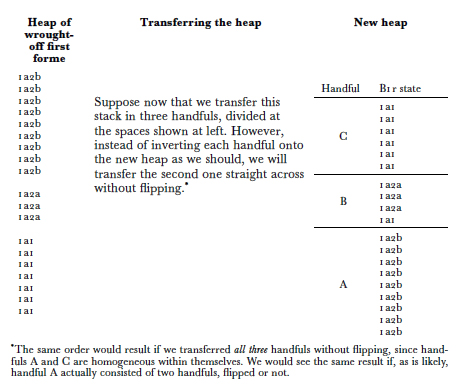 |
A stack turn with handful B transferred without flipping is the only
scenario
that yields the observed results if we assume the printer started the
perfecting
run at the top of the stack and worked his way straight through. Our
thought
experiment also shows that state iai of B3v-4r most likely came first. If
state 1a2
had been earlier, we would have to hypothesize a second turning of the
garbled
stack—this time correctly done—yielding the inverse of the first column
above.
The reader may verify that this does not yield the observed distribution of
states.
We cannot change the boundaries of group B without creating a conflict
with the
observed combinations, so that cohort must represent the survivors of a
manageable
number of sheets that the worker was comfortable picking up with
two
hands. It is tempting to extrapolate from our nineteen-copy sample to
estimate
the total number that were printed in Phase I. If group B represents one
"grab",
the total first printing of the quire might have contained four roughly
equal
handfuls of damp sheets, each of which in ToP
measured about 41 by 31 cm.
25
A
practical trial might provide an estimation of the edition size. However, it
proves
difficult to locate a source of poor-quality, lightweight, handmade paper
with

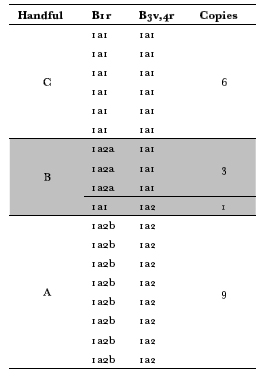 |
getting usable data from present-day fine printers regarding their paper-turning
habits. It turns out that there are a host of variables that make it impossible even
to approximate an upper limit on the edition size by this means.
It should make us slightly uncomfortable that B1r state 1a2b is
absolutely
coextensive with group A. The last handful (or more likely two) appears
to have
contained only that state, which occurs nowhere else; and state 1a2a is
found
only in handful B. If my analysis above is correct, and if further copies of
ToP
were to come to light, one of them might contain
B1r:1a2a combined with a
later state of B3v-4r.
B. QUIRE B, PHASES II-IV, OUTER FORME
The next phases of quire B are so complex that it is necessary to analyze the
two
formes separately.
After Phase I, three of the pages of B(o) were reset and one (B3r) was
reprinted
with a new skeleton. Phase II's only variants occur on B4v (in states
2a1 –3) in the
passage "ayre, ... with an artificiall bellowes coold". The last
word also appears

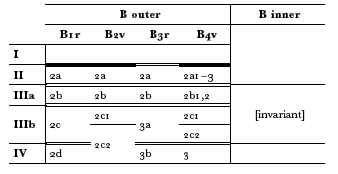 |
the variants probably result from a two-stage accidental loss of letters from the
end of the line. Frisket slip is not a suspect here because there are no intermediate
states—the letters are either completely present or completely lacking.
For Phase IIIa, all of the pages have new skeletons. Page B4v state 2b2,
found
uniquely in a copy at St. Catharine's College, Cambridge
(Z.59), presents
a problem because the page number has shifted horizontally.
However, the type
appears to be the same and the page is unchanged in other
respects, so reimposition
is not likely to be the cause. If looseness in the line
caused the shift, we
would also expect slightly different spacing among the three
characters of the
page number, but we do not see this either. It remains an
unexplained problem,
but a minor one.
In the discussion of quire A, I identified a point within Phase I at which
press-
work was interrupted, but the other formes of the book from that phase did
not
show a similar hiatus. Sub-Phases IIa and IIb were in effect separate
printings of
quire A, with both formes showing changes. Quire B is a slightly
different case.
Again, it appears that a more urgent job interrupted the printing,
this time during
Phase III of the outer forme. The delay was long enough that the
type-pages
were stripped and probably tied up. After the other job played through,
printing
of B(o) resumed with a new skeleton, including a new arrangement of
acorns on
B1r. (I have not been able to determine whether the direction lines were
reset as
well—they are closely similar.) These re-imposed copies constitute Phase
IIIb.
However, both of these impositions of the outer forme occur with identical
states
of the inner forme. The two sub-phases of the outer forme seem to have
gone
through a single perfecting run.
26
Apart from this one forme—and a couple of
other small variants
which I will discuss in §11–14—these five copies resemble
the twelve others from
Phase III.

The following corrections demonstrate that Phase IIIb indeed followed
Phase
IIIa:
 |
In Phase IV of this forme, a few things are of interest:
- On B1r, the page number wanders a bit horizontally over the 15th
pair
of acorns. - Likewise, on B2v, the stem of page number "4" can point to the first
letter
of "the" below, to the "o" in the preceding word, or anywhere in-between. - In this phase, B3r picks up the first three lines of text (in a new
setting)
from the following page, relieving some crowding on the latter. - On B4V, the four flush-right italic lines have been raided and are
reset in
smaller (pica) size. The two centered italic lines on the same page are unaffected,
perhaps because it was not worth the trouble to get at them. On this page also
the page number is horizontally unstable. This example of wandering, along with
items 1 and 2 above, are among many in ToP that demonstrate that lockups on
the press bed must have been much less rigid than Joseph Moxon's descriptions
would lead us to expect.
C. QUIRE B, PHASES II-III, INNER FORME
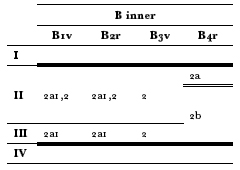 |
The inner forme of quire B is even more perplexing than the outer one.
Phase II
begins with a complete resetting of all four pages. Shortly afterward,

direction of the change from 2a to 2b is confirmed by a textual correction and
progressive damage to line 7 during state 2b. For only one page of a forme to
change its skeleton is puzzling enough. But it also occurs against a background
of changes to its forme-mates B1v-2r which do not develop in consistent directions.
These variants are:
B1v: The "V" beginning line 10 is more or less displaced downward, or is
entirely
absent. Where it is absent, the "D" from two lines down drifts up into
the vacant
space.
- B2r: 1. St. Catharine's College (Cambridge)
Z.55 shows a unique setting of
the page number. The number "3" comes from a different font than that found
elsewhere in the book, being rounded and with the upper loop noticeably smaller
than the lower. It is evenly spaced between undamaged parentheses. All the other
copies have the usual narrow "3" with loops about the same size, and one or
both of the page-number parentheses are either damaged or fouled with ink. This
number was apparently not locked up tight, and it can fall anywhere from close
to the left parenthesis to centered between the two. The direction line appears
to contain the same type as does the St. Catharine's copy. - In some exemplars, the right ends of lines 1 and/or 4 creep upwards
by
varying degrees. - The comma ending line 6 prints either normally or as a blob.
- A stray bit of metal resembling a hyphen may show in the empty
space
between lines 6 and 7 and below the "na" of "nature" in line 4.
A tabulation of these features shows some correlation among certain
manifestations
of variant 1 above (a bit of dirt on the right parenthesis at about
2 o'clock),
variant 2 (both lines displaced), and the blobby comma in variant 3.
But other
characteristics do not line up, either with each other or with the
amount of type
damage on B4r. Most of the features are of a transient nature and
could be
reversible: for instance, the wayward "V" on B1v could drift, fall out,
and be
replaced, so late copies might look like early ones. The loose page number
with
its parentheses could have fallen apart near the end of the run, and all
three types
could have been reset to produce the unique manifestation in the St. Catharine's
copy. The stray metal in variant 5 could have
been slightly raised in the forme
throughout this phase, but would print only when
sufficient pressure
Excessive attention to these details might not be either productive or
healthy,
but it is not so easy to dismiss the skeleton change on B4r early in
Phase II (the
transition from state 2a to 2b), mentioned above. Because there is
no evidence
of changes on the other three pages of the forme at that point, it
presents a challenge
to my theory that arbitrary page-number changes are signs of
work stop-
pages. It is another occurrence I will have to leave unexplained.
D. QUIRE B, PHASE IV, INNER FORME; QUIRE B RECAPITULATION
The final phase (IV) of forme B(i) shows a resetting of all the pages. For
no
obvious reason, the four-line roman-face stage direction on B3v beginning
"The
Gentleman ..." is now set in pica, one step smaller than the surrounding
text.

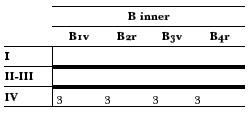 |
Combining all that we have discussed about both formes of quire B generates
table
20, which is puzzling in its fragmentation and necessarily evasive
about
correlations among certain states below a certain level of detail.
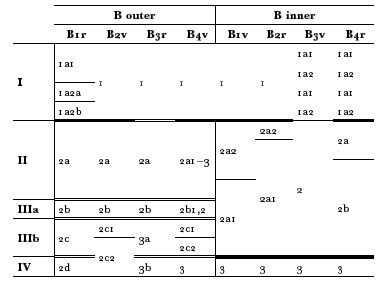 |
Nevertheless, it is possible to discern two events, initiating Phases II and
IV,
that clearly interrupted work on the entire quire. These resulted in the
resetting
or reimposition of almost all the pages. The outer forme underwent two
more
skeleton changes on its own, introducing Phases IIIa and IIIb.
What I have
called state 1a1 of B3v has "off throw" in l. 10; B4r ll. 16–17 read
"This
[man] with a face Philosophicall and beard / Hath with the study of
twenty yeares found out / A lampe ...". State 1a2 of both pages respectively have
"off, throw" and "This with a face Philosophicall
and beard, / Hath with the
study of twenty yeares, found out / A lampe ..."
The five witnesses to quire B's Phase IIIb are at the Newberry, Bristol Central
Library,
the Elizabeth Club (Yale), the Bodleian (Mal. 160(3)), and Dartmouth
College.
§7. Quire C
Table 21 shows four relatively clear-cut phases of production for all of quire
C.
Phases II and III are signalled by reimpositions or resettings that run
straight
across both formes. Phase IV is more subtle, having only two pages
reimposed.
But the remaining pages (except for C3r, which comes over completely
unchanged
from Phase III) all show revisions, some of them major, at the inception

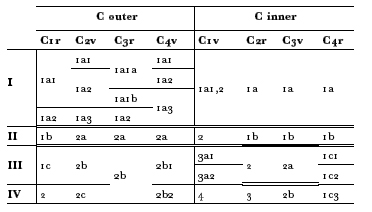 |
we have already shown initiating the final printing phase of the preceding quires.
(Appendix 3 shows this correlation most clearly.) Phase IV of this quire is found
only with the "third impression" title pages and vice versa. So, despite the lack of
extensive resetting at this point, we can still assert
the likelihood that the alterations to both formes preceding this final phase took place during a significant
pause in the press run.
On C2v, the action of the masque enters its final phase, which features
numerous
songs set in italic. These provide the main source for the italic
raids
discussed in §3.
The production of the quire went as follows:
A. PHASE I
C outer forme shows a normal pattern of variants whose sequence is all
but
certain. The inner forme, however, presents an insoluble problem in the
sorting
of the two variants of C1v, which at line 23 has either (1a1) "We
change
the Seene" or (1a2) "We change the Scene". These are found in the
combinations
shown in table 22. (The remaining three pages of C(i) are invariant,
so
are not shown.) About half the sheets (the eight copies shown in the last row
of
the table) have the latest states of both the outer and inner formes, as we
would
expect, but the other ten sort illogically. Unlike the retrograde pattern of
quire
B Phase I (§6A), the existence of all these permutations cannot be
explained
by any plausible irregularity in turning the stack. Only dropping some
portion
of the sheets on the floor and picking them up more or less at random
would
cause the first state of the inner forme to be printed on the back of three
of the
four variants of the outer forme. "Accidents at the press" is the last
resort of the
baffled bibliographer, and I will not waste space here in trying to
develop such an
explanation.

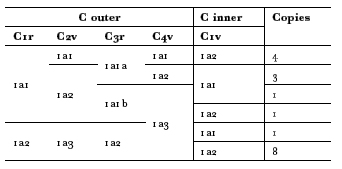 |
On C4V the bottom lines of text are bent upwards at the right. The
greatest
amount of deflection is a bit more than 2 mm—so, rather less than half
the
height of one line—but bad register with the text on the back of the leaf
makes
it quite noticeable. This much distortion would be impossible if the
non-printing
space on the page were packed solid; there must have been a gap in
the lockup,
and I would guess that one of the lines of Song 5 somehow got into the
forme
without being justified. Such an oversight would also explain the slight
misalignment
in lines 7–9 on the same page. This precarious situation might have
made
it impossible for a workman to pick up and transport the locked-up forme
in
the manner described by Moxon,
27
but the interaction of pressures along both
dimensions of the
page was apparently sufficient to keep types from being pulled
during presswork.
This is the most graphic demonstration in ToP that
printing
could proceed with adequate stability even if regions of the forme lacked
support
on all four sides. We have already seen instances in §6B of wandering
alignment
between adjacent lines that probably arose from similar causes.
27a
B. PHASE II
Phase II shows raiding of italic on pages C2v, C3r, and C4v. These pages
contained
all of the main caches of italic in the outer forme. C4v was
particularly
heavy-hit, being totally reset except for the roman lines 7–9 and the
last line. After
the raid, the italic Song 5 and its roman title on that page
reappeared in pica size.
The inner forme of quire C offered an even richer source of italic than
the
outer, but it was never raided at this point, or ever during the history of
ToP.
The reason is probably that C(i) was on the press
and inaccessible while C(o) was
being raided. C1v does show resetting of the
italic in lines 8–10 and 25–27, but
this page was not a plentiful source for the
font, and the resettings could have
arisen from some other cause. (For instance,
the earlier state showed a comma

repositioning it.)
C1r in this phase shows some horizontal instability in the
page-number
position.
C. PHASE III
In this phase, pp. C2r and C3v—which lie side by side in the forme—undergo
the
only complete resettings in the history of quire C. Head to head with
these, but
later in the phase, C1v and C4r both show page-number shifts. These
are probably
simultaneous but random drifts, as the types in the page numbers
appear to be the
same before and after. However, the five copies which show this
deviation happen
to be the same ones which contain quire B from Phase IIIb. I
will discuss this
uncomfortable coincidence in §13.
Also in this phase, the text of C1v shows further instability around the
same
points which changed in Phase II: the italic in lines 1 –10 and the last four
lines
is reset, the fourth line up ("A Landschape the
Scene.") going missing in the first of
two steps to a smooth transition
between antimasques. When lines 8–10 were
changed in the previous phase, the
period after "carryed off" in line 9 ended up
below the line (which shows another
unstable lockup). In Phase III, it is properly
aligned, and the resetting of the
nearby italic may have had some connection
with that repair-work.
D. PHASE IV
Phase IV, as mentioned above, is found only in "third impression" copies of
ToP, and, like the final phase of quire A, it introduces
important textual revisions
that alter the page breaks within the quire. Edits on
C1v and 2r shorten the word
count significantly, causing two-line chunks of the
text to move backwards until
the original breaks resume at the end of C2v.
This phase gives us further examples of text that is reset either larger
or
smaller than the prevailing 96 mm "english" size:
C1r: At the top of the page, a brace separates the list of three characters
from
their stage directions on the right. In the original setting, the directions
crowd
right up to the brace. In Phase IV, the direction is reset in 82 mm pica;
the line
breaks are the same, but the page gains some needed white space.
C2r: The antimasque of the "phantastique Adventurer" has the same layout
as the
previous example, with a brace separating the names of the characters
from their
stage directions. In this last phase, the directions are rewritten and
lengthened,
so the compositor reset them in pica type apparently to maintain
visual
balance.
Peter Blayney's recent work on
quotation quadrats ("Quadrat Demonstrandum,"
PBSA,
111.1 (March 2017, pp. 61–101) gives a probable mechanism for some of
these
displacements.
§8. Quire D and "A Speech"
Readers who have followed me to this point will, I trust, agree that the
thirty-six
pages of The Triumph of Peace comprise a Wunderkammer of bibliographical
problems, any one of which
could support a separate study. The last quire will
not disappoint.

A. QUIRE D PHASES I-II
Quire D begins life with an outer forme showing an orderly progression
of
variants:
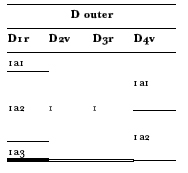 |
The second state of D1r supplies a missing word; at the same time the first
three
lines lose their horizontal alignment. This state gives way to a third one
in
which the same three lines of type are damaged. D4v shows a more subtle
change, in
which the right parenthesis of the page number suffers damage near
the bottom;
this occurs while D1r is in its second state.
The inner forme on this set of sheets also shows a regular progression, but
with
a clear work stoppage indicating two phases:
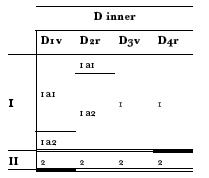 |
The variants are
D1v: State 1a1 has a comma that has slipped into the line below, and a
damaged
parentheses to the right of the page number. In state 1a2, the comma
is
correctly positioned and the parenthesis is sound. This sequence, which
could
have gone in the opposite direction, is confirmed by

D2r: The second state (1a2) corrects a typo, improves sense by adding a
comma,
and pushes down one of two quads that were printing inappropriately
in the first
state.
The conspicuously damaged parenthesis in D1v:1a1 is the same one found on
C2v,
also in Phase I, in the same position to the right of the page number and in
the
same quarter of the forme. This recurrence gives us a clue about the order
of
printing these quires in Phase I. There are two possibilities:
- Quire D came first. The damaged parenthesis was removed
part-way
through Phase I as one of five stop-press improvements to the inner forme, but
instead of being discarded it was put back in the type-case and later set—coincidentally
in the same position—in the headline of C2v. - Quire C came first. After Phase I of that quire the damaged
parenthesis
either persisted on D(i) as part of the skeleton, or returned to
the type-case to be set—coincidentally in the same position—on D1v. In either case, part way
through Phase I of quire D, its damaged state caught the eye of the corrector
and it was discarded.
The second possibility—that the parenthesis remained as part of the skeleton
and
was later replaced by a sound type—is much more likely; and indeed this
damaged
parenthesis never reappears in later states of ToP.
The independent typographic evidence that Phase II of the inner forme
followed
Phase I is rather slight: the correction of one error in line 8 of D3v,
which
kept the same setting of the first twenty-one lines from Phase I. However,
as most
copies of ToP containing Phase II also contain
later states of quires A-C, we can
be confident of this direction of change.
When we put together Phases I and II of the two formes of D, their
relationship
becomes complicated:
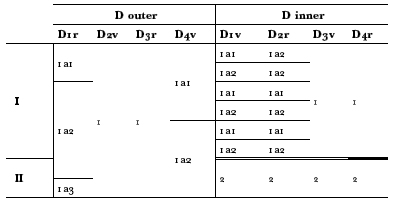 |
This table shows two oddities beyond the fault-lines indicating the pauses
in
production, which by now we have become accustomed to:
- There were two production phases of the inner forme, marked by
skeleton
changes on three pages (D1v, D2r, and D3v) and a complete resetting of D4r.148However, the outer forme of the same sheets appears to be the product of one
continuous printing, with states 1a2 and 1a3 each appearing within Phases I or II,
not during a pause between them. - Phase I of this quire shows an illogical mixing of states between the
two
formes. If we consider only the states in this phase and ignore the invariant pages,
the scheme looks like this:
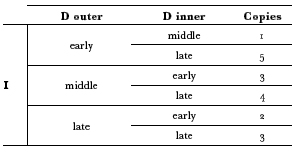 |
This is very nearly a random shuffling; like the permutations of quire C in
Phase
I, it cannot be attributed to any plausible method of flipping a single stack.
The
three combinations that do not occur are early/early,
middle/middle, and
late/middle; but there is no guarantee that these would not
emerge if new copies
of the book were to come to light. As with quire C, I am
unable to explain the
distribution of variants here.
Point 1 above—the fact that the inner forme goes through two production
phases
while the outer forme appears to have only one—is easier to explain if
we suppose
that the outer forme went through two printings with no alteration
during the
pause between them. Phase II of D(i) associates mostly with the third
state of the
outer forme (D1r:1a3), in which the first three lines of type on D1r
show damage.
The accident that caused this may in fact have come in the transition
to Phase II.
The distribution of surviving copies is as follows:
 |
Only two copies (McMaster University, and British Library Ashley
1697,
shaded above) show sheet D with its inner forme from Phase II
but the outer
forme in the undamaged state typical of Phase I.
28
If we take the hypothesis that

the inner forme, there are at least two possible explanations for the observed
distribution:
- The damage occurred early in the second printing of D(o), or
- McMaster and Ashley 1697 represents a small residue of
sheets which for
some reason were not perfected during Phase I. The damage occurred during
the replacement of the outer forme in preparation for Phase II. The Phase II
sheets with the damaged type were combined with the Phase I leftovers and
perfected with Phase II of the inner forme.
It is more likely for damage to occur at points of transition than during
periods
of repetitive work, so I lean toward the second explanation. Either one
requires
some special pleading to fit the hybrid copies into a plausible narrative.
There
is no doubt, though, that they are closely associated with the skeleton
change in
D(i), which marks the end of Phase I of that forme, and the same phase
also
produced about equal numbers of quires A-C.
Before Phase II came the pause during which italic was raided in quires A
and C.
Norton raided quire D as well, but only the inner forme. Three of its
constituent
pages show the italic in a new setting in Phase II, while the
fourth
page—consisting almost entirely of italic—was entirely reset. D3r, in the
outer
forme, could have supplied a good amount of the font but was not
touched.
For Phase II of quire D, Norton printed the outer forme, as I have
argued,
unchanged from its Phase I state except for the damage to D1r (which could
also
have happened early in Phase II). Following Phase II, another small italic
raid
occurred on both formes, carrying off the songs on D2r and D3r. The former
leaf
had already been raided, even more extensively, following Phase I. The
second
raid shows a continuing need for the font beyond its earlier use to set the
dedication
for ToP; some other job was interrupting at this
point. Concurrently with
these replacements, and quite bafflingly, the roman
portion of D3v—about two
thirds of the page—was reset. I cannot begin to suggest a
reason for this.
B.QUIRE D PHASES III-IV
Uniquely for ToP, Phases III and IV of quire D contain two
different settings
that mix randomly in copies containing Phases III and IV of the
other quires. I
will call these settings A and B:
 |

Setting A, in six out of the eight pages of the quire, is simply a reimposition
of
the standing type from Phase II; the first two pages are reset. Setting B
contains
typographic features not found elsewhere in ToP,
nor in any of Norton's printing
from the years 1633–34 that I have
seen. The characteristics are:
| Quire D, setting B | Rest of ToP (Norton) | ||
| k | The diagonal arms are stunted, the upper-right serif failing to reach the x-height and sometimes tilted upward. | k | The upper diagonal arm consistently reaches the x-height. |
| w | In some examples, the left V meets the right one a bit downward from the middle serif; the bottom of the left V falls below the baseline of the right one, so that the letter usually appears to tilt to the left. | W | The left and right V's meet the middle serif at the same height, and the letter does not tilt. |
| h | The curvature of the legs is midway between that of Norton's i-1 and i-2; the right leg ends pointing left. | h | In i-1 the legs curve slightly toward each other but do not approach closure; the right leg ends pointing 45 degrees below horizontal. In i-2, they close almost completely; the right leg ends pointing straight left. |
| 3 | Full-bodied. | 3 | Abnormally narrow. |
| o | Ranges with the other lowercase letters. | o | Usually too large. |


These are strong tendencies, not invariable markers, but the differences
are
pronounced enough to indicate that a second printer's type was used in
setting
B. The immediate suspicion falls on Nicholas Okes, with whom Norton at
this
time had an informal and increasingly fractious partnership.
29
Okes had already

his 1609 stock as catalogued by Peter Blayney 30 —Norton is known to have filched
other woodcut material during their association. To confirm my hunch about
Okes, I surveyed English books printed in 1633–34, searching for the odd "k"
and "W" in particular. Unsurprisingly, this did not yield an unequivocal answer.
Early-modern printers' typographic stocks were not proprietary, homogeneous,
or static, and there are no woodcut elements in quire D to help finger the collaborator.
I found versions of the stunted "k" in the repertoire of numerous
printers, including at the university towns, and "W" showed great variability in
most samples. Many texts I looked at did not even contain english-size type—
the smaller pica is much more common—and a good proportion were Latin, in
which letters "W" and "k" are rare. My search for definite fingerprints became
an exercise in probabilities, trying to estimate frequencies of the characteristic
sorts in scattered pools of the target font. In the end, though, my survey supported
Nicholas Okes as the most likely owner of the type used in quire D setting
B. 31 A hardier investigator than I might be able to clinch the identity with
a survey of broken types in Okes' other productions, but for narrative simplicity
in this account I will treat it as a certainty.
Though Okes' type may appear in setting B, we cannot assume that he had
personal
responsibility for the printing. A series of undated petitions beginning in
late
1635 shows a deteriorating relationship with his partner. Okes' most
interesting
complaint is that Norton, "wanting Capacitie himself for the
Government
of a presse hath enterteined ayded & assisted a Company of
disorderlie & factious
persons for the erecting of an unlawfull presse in a
secrett place, and hath
without [my] knowledge & Consent ... secretly conveyed
out of [my] house [my]
formes and lettres which afterwardes were discovered and
seized by the master
& wardens of the Company of Stacioners & at their
hall melted and defaced to
[my] great disgrace and losse."
32
The chronology of these events is vague,
but
another document, dated January 1635, reinforces the impression
that both men
were accustomed to playing fast and loose in their business. This
list, endorsed
by Sir John Lambe of the High Commission,
claims that the two printers jointly
employed, in addition to five authorized
apprentices, six individuals "brought
upp to Printing against order".
33
The latter group, which included a
butcher,
a gingerbread maker, and a garbler, may have constituted the "disorderly
and
factious" team that Norton recruited to run his clandestine press. There is
no
evidence that the "Okes" ToP quire D was printed
off-site, or even that Norton

operated in the shadows, and we cannot take for granted the ostensible paternity
of any of their productions.
Okes' setting of quire D occurs in seven of the seventeen surviving copies
of
Phase III and in four of the nine copies of Phase IV Possibly Norton and
Okes
each printed about equal numbers of sheets to supply the last two phases, or
Okes
printed rather fewer. I have not found any variants in Okes' sheets. Although
the
typesetting is not error-free, one gets the impression of a more assured
compositorial
hand than Norton's crew could muster. It is not clear why Norton
brought in
a second printer at this late stage to run off a "duplicate" setting of
the quire. In
§16, I will show that the time gained by running the same eight
pages of text on
two presses was nearly offset by the time taken in setting them
anew. The complications
of using a clandestine off-site press would further reduce
or even negate
the advantage. This consideration, along with the greater
professionalism of
Okes' quire D setting, argues against Norton's direct agency in
its production.
We know that Phases III and IV of sheets A-C contain multiple impressions,
so we
would expect sheet D to show evidence of this as well during Okes'
involvement.
However, as mentioned, Okes' sheets contain no variants that I
have
identified. Norton's sheets for Phases III-IV are also virtually identical,
but D1r
shows some interesting small changes:
2a1: l. 10 has "Masqncrs"; signature mark under the "hi" of "white,"
2a2: l. 10 has "Masquers"; signature mark under the comma of "white,"
2a3: l. 10 has "Masquers"; signature mark under the "w" of "white,"
From the spelling correction it appears that states 2a2 and 2a3 follow 2a1.
The
shifts in the direction line raise the spectre of reimposition. However, the
signature
mark—anomalously, an italic "D"—appears to be the same type in all three
states.
(Transient bits of foreign matter appear either as specks within the
letter [mostly
in 2a2] or falling across one or the other serif.) The page number
also appears
invariant in composition and position. It would be tempting to
attribute the states
of the direction line to random shifts due to loose lockup,
except that there are n
ointermediate states, and the variants tend to sort in a
complex but fairly orderly
fashion with sheets of the other quires. Norton's
states of sheet D show the following
distribution:
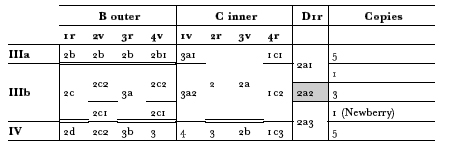 |

The table shows that state D1r:2a1 is found only with Phase-III copies of
the
other quires, while 2a3 associates (with a single exception) with Phase-IV
copies.
State 2a2 (shaded) is transitional between 2a1 and 2a3, and it occurs in
copies
having B(o) from Phase IIIb. Those same copies have unique states of pages
in
the inner forme of sheet C. In §11–14, I will return to these links among
the
three quires. For now, it appears that the D sheets containing Norton's
D1r:2a3
could represent a discrete Phase IV, his final one for that quire. The
"leakage" of
2a3 into Phase III, represented by the Newberry copy, could have
resulted from
Norton's having printed sheet D a bit short in phase III. Thus, a
small group of
Phase-III copies of the book may have been made up with Phase-IV
sheets of
quire D. Those hybrids probably went to the warehouse along with the
purebred
Phase-IV copies.
If we accept that Norton printed Phases III and IV of quire D as
distinct
impressions, what about Okes? Might he have printed all his sheets for
both
phases in one go? If we allow this possibility, we have to explain the fact
that, in
the surviving copies, Okes' contribution makes up about an equal
proportion in
each phase: respectively 41 and 44%. When, after Phase III, a
workman began
collating complete copies, he would probably start picking D-sheets
from a homogeneous
batch of one or the other man's production, whichever came to
hand
first. This process would almost certainly produce different Norton/Okes
ratios
in Phases III and IV So, either the D sheets after Phase III already
contained
about 40% of Okes' work, or Norton deliberately manipulated the ratio to
equal
that in the upcoming Phase IV. Such an intervention supposes obscure
motives
and more fastidiousness than I can credit Norton with. The same objection
applies
to a hypothesis that both men printed their sheets for Phases III and
IV
in a continuous run. The more plausible explanation is that Norton brought
in
Okes to print a half-share of Phase III sheets, but asked him to keep the
eight
pages in type, skeletons intact, against a probable fourth printing. When
that
need came about, Okes was able quickly to reimpose the pages without
alteration
for the new run. This scenario asks a high degree of precision from
Okes, and
requires that he tie up eight pages of type without knowing for certain
whether
they would be needed—otherwise, why not go ahead and print Phases III
and
IV together? I cannot give a detailed and definitive account of Okes' work
cycle.
It is intertwined with the mystery of why he got involved at all; if we
knew the
answer to one, the other would probably follow. However, I favor the
theory
that Norton's and Okes' teams worked in tandem on Phase III of quire D,
and
that—on the slim evidence of surviving copies—each produced an
approximately
equal number of sheets, of which Norton's contained states D1r:2a1
and
the much less common 2a2. Once they reached the end of Phase III, the
pages
of type from both printers' pairs of formes were tied up and there was a
pause,
during which completed copies from Phase III were assembled and
dispatched.
After an indeterminate time came Phase IV, for which both printers
again machined
approximately equal runs of their respective settings of quire D.
Norton's
sheets of these final copies differ from those of Phase III only in the
position of
the signature mark on D1r, which moved about three millimeters,
probably during
the reimposition process, producing state 2a3 of that page.


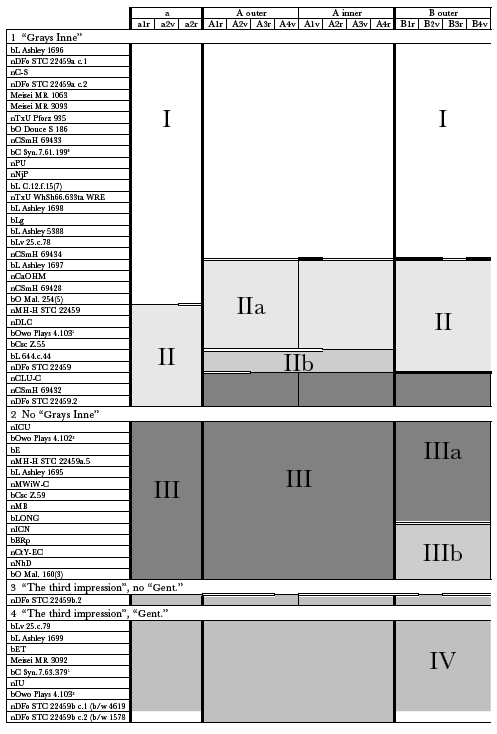 |
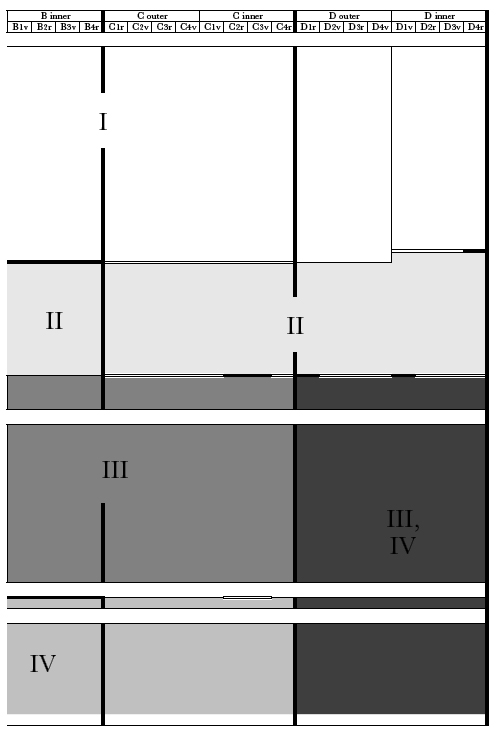 |

Norton and Okes seemed to feel that a further impression would be called
for
after Phase III, but something prevented them from going on to print a
double
run of quire D. The publisher Cooke may have been uncertain about
demand.
But Phase IV also ushers in the bulk of the substantive textual variants
in ToP
These occur in the description of the procession on
A2r and A3r, in the tavern
direction on B3r, and in antimasques on C1v and C2r.
None of the variants are
stylistic; they seem rather to document actual changes in
the performance. By the
end of Phase III, Norton and Okes may have known that
revisions were coming.
Although, in the event, none of these fell in quire D, the
printers may not have
known this, and therefore put the type-pages for the last
quire aside until the
matter was settled.
The singleton epilogue leaf "A speech to the King and Queenes Maiesties",
found
in only four copies (and Greg's own copy, now untraced),
34
exists in a single
state, printed by Norton using
mostly his workhorse italic i-1. The page is headed
by the now-familiar motif of a
double row of acorns (28 pairs in this case). I will
consider the history and
status of this addendum in succeeding sections.
Alan B. Farmer, "John Norton and the Politics of Shakespeare's
History Plays in
Caroline England", in Shakespeare's Stationers (ed. Marta
Straznicky, Philadelphia: University of
Pennsylvania Press, 2013),
pp. 147–176; Peter Blayney, The Texts
of King Lear and their Origins
(Cambridge: Cambridge University Press,
1982), pp. 304–313; C. William Miller, "A
London
Ornament Stock: 1598–1683
(Studies in Bibliography, 7 [1955], 125–151
[131–136].
Blayney, op. cit., p. 445, factotum 1 (rotated
180°). An apparently early casting of Okes'
type appears on p. 46, fig.
4.
The next most likely were Thomas Cotes
(introduction to STC 25957), William
Jones
(dedication to STC 20464), John Legat
(dedications to STC 4223), and Richard Badger
(introductions
to STC 23490).
Undated petition to the Court of High Commission. Blayney, Lear, p. 311,
quoting
from National Archives, State Papers, Domestic Series, Charles I, 16/376/21.
§9. Order of Printing the Quires
In the preceding sections, we have been exploring ToP
"vertically", as it were
—working out the histories of individual pages, studying
their chemistry as they
combine into formes and quires, and watching each quire
evolve in isolation
from the others. It is now time for a "horizontal" approach as
we begin to reconstruct
the progress of printing the whole text, phase by phase.
Table 30, a
modified version of appendix 3, shows how these phases align across
the quires
of the surviving copies. It shows a fairly orderly stratification: for
a given copy
of the book, the phase of any one of quires A-C serves as a good
predictor of
the phases of the others. The few exceptions to this among the
survivors result,
I believe, from the occasional necessity of making up copies
with sheets from
neighboring phases. (I will discuss this further in §11–14.) But
the phases do not
leapfrog one another: II and IV never mix in a copy, nor III and
I or IV and I.
If sheets from more than one phase were available simultaneously
for gathering
complete copies, there was nothing to stop Norton from mixing them
indiscriminately,
because the text-breaks across quires never change. Except for
the "third
impression" copies he would have no motivation for keeping the products
of
one phase segregated from another. Therefore, I think we can safely hold to
the
theory of four discrete printings of the book as a whole.
The recurrence of types can give us clues about the order of printing the
quires.
(Lacking evidence to the contrary, I will assume for the ensuing discussion
that
the order of printing in ToP is the same as the order of
composition.) We would
expect Norton to work through quires A-D in sequence. But
here, as so often, ToP
hands us a surprise. The recurring
types in the first phase of printing that I could
confidently identify are
distributed as follows:

A. PHASE I
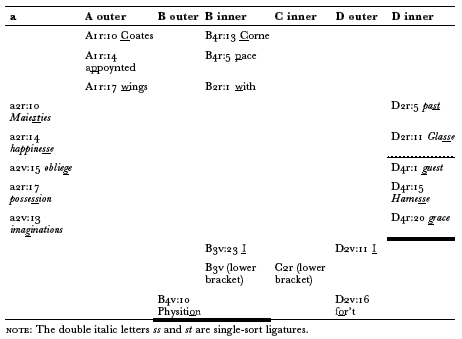 |
On first glance, the table appears to show nothing out the ordinary. Quire
B
inner forme could have been set with type distributed from the outer forme of
A;
Norton could even have begun at the title page and proceeded straight
through
the book. But we need to take into account what happened to the
individual
pages at the end of Phase I. In fact, the outer forme of quire A
remained in substantially
the same setting through the printing history of ToP, whereas quire B
was distributed after Phase I. So, types
from A(o) were not available to set B(i)—
rather the opposite. Therefore, A(o) was
set after B(i) went through the press and
got broken down. Similarly, quire "a"
continued to hang onto most of its type
(predominantly 96 mm italic) while D2r was
raided for its italic after Phase I. (I
have indicated the point of the raid with
a wavy border in table 31, distinguishing
the fate of that page from that of D4r,
which was entirely distributed.) The
preliminaries could not have been set until
printing was finished on quire D inner
forme. Furthermore, two letters on D2v show
that that page could not have
been set until after the distribution of at least
part of each forme of quire B; and
a distinctive bracket on C2r shows that C(i)
cannot have been set before B(i)
was off the press. So, quires C and D both
followed B. In §8A, I showed, on the
evidence of one broken parenthesis in the
headline, that quire D was probably
printed after quire C. No other types from C
show up elsewhere; it was probably
set while quire B was still being worked off,
after which it held onto most of its

have supplied some other printing job than ToP. If, then, we may consider entire
quires as production units, it appears that the printing of Phase I followed the
sequence B-C-D-A-a. Nothing in the data shows that the preliminary quire "a"
had to come last, as long as it followed D from which it drew some of its type. But
preliminaries were normally printed at the end of the job, and if "a" followed D
directly, there would have had to be a pause for D(i) to be at least partly distributed.
(Remember that in ToP the inner formes were printed after the outer ones,
and it is only D(i) that provided types for quire "a".)
Something caused Norton to place quire A late in the schedule. A probable
reason
emerges when we recall that quires B-D contain the text of the masque,
while quire
A sets the stage, as it were, with a description of the costumes, scenery,
and the
public procession that opened the performance. Most of this is written
in the past
tense, as if reporting the finished event, while the stage directions
for the
masque itself are mostly (though not exclusively) in the conventional
present
tense. This division between reportage and direction again raises the
question of
whether copies of the book were in fact available on the day of the
first
performance—a matter which I will explore further in §16. The important
point here
is that the details of the procession were more likely to be in flux until
the
last minute, whereas a relatively stable text of the masque would have been
needed
earlier so the performers could learn their parts. Though both sections
show light
revision through the printing history, it would have made sense to
start work on
the part least likely to change. Quite possibly, Norton began typesetting
the main
text before Shirley had even finished writing the
description of
the procession.
If typesetting and printing began with quire B, as the evidence above
indicates,
this may explain why this quire alone was mostly distributed after
Phase I—
seven of its eight pages broken up, as opposed to only one page each in
quires A
and D, and none in C. I have already mentioned the often arbitrary
pattern of
which pages got distributed and which survived into later impressions.
However,
this first quire printed could represent an initial intent to play by the
rules and
distribute type after running an impression—a routine that Norton could
discard
if he learned that he would have to achieve faster production than
planned.
Two other observations are worth mentioning here:
- Quires A, C, and D have a type-page width of 89–91 mm, but quires "a"
and
B measure 97 mm—three ens of english type wider. 35 These different widths
imply at least two differently adjusted composing sticks, suggesting more than
one compositor. - 2.The last page of quire B has some overly generous leading, indicating
some
distress in copy-fitting. This could reflect a compensation for the unexpected
use of the wider measure just mentioned.

B. PHASE II
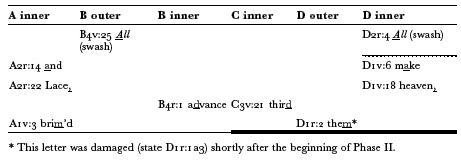 |
After Phase II, only four pages were distributed, plus italic portions of D2r
and
D3r; recurring types therefore provide less evidence for the order of printing
in
this phase than for Phase I. (The wavy border below D2r in this table shows
that
only the italic portion was reset; one of its types turns up on B4v.) Here
again,
it appears that quire A was printed after quire D: D1v was distributed at
the end
of this phase and two of its types show up on A2r. On the other hand,
quire A held
onto most of its type from this phase onward and could not have
supplied it to D
or any other quire. It also looks (on the evidence of only two
types, but both are
quite distinctive) as if quires D and C were finished print-
ing before quire B
could be set—again, because quire B carries its types largely
unaltered into the
next phase, while the donor pages in quires C and D give up
type after Phase II.
These observations show that quires C and D were printed
before quires A and B.
The fact that Phase II of quire A actually consisted of two
separate printings
complicates the picture. In §5, I suggested that, after an inter-
ruption in the
Phase-II printing of A(o), Norton chose to perfect the sheets he
had already
printed rather than resuming the planned run of the outer forme and
then
perfecting both sub-impressions in a single operation. The motive would be
to
prioritize the completion of at least part of the planned impression of sheet A
in
order to get some complete sets of sheets to the publisher for sale. This
strat-
egy would make more sense if quire A came later, even last, in the sequence
of
quires as printed. However, if quire A came last and if therefore B followed
D
directly, the composition of B's outer forme (the first one printed in B) would
have
had to wait for the italic from D2r (in the second forme printed in D) to
become
available. This would leave the press idle, at least for purposes of
machining ToP.
If, instead, A followed D directly, its
outer forme would still be standing from
Phase I and printing could have proceeded
on that while D was broken down
and the types incorporated into A(i). So, the
slightly more likely sequence for this
second phase of printing was C-D-A(Phase
IIa)-B. Probably Phase IIb of quire A
came last, but it cannot have been delayed
long because two of the three surviv-
ing books that contain it also have Phase II
of sheets B-D.
The textual changes in quire A are minor for Phase II and would have had
no
bearing on a decision to leave the production of that quire for later. Possibly it

B, on the other hand, came into this phase with only one type-page intact; all the
others had to be reset. So, it would have made sense to commence printing with
quires C, D, and A, leaving time for the resetting of B.
I have left quire "a" out of the discussion for this phase because it holds
onto
most of its original types throughout the production. We would normally
expect
it to come late in the series, probably after quires B and/or A(Phase
IIa).
C. PHASE III
 |
This phase began with the resetting of four pages, italic raids on two
others,
and some localized resettings. Only the inner forme of quire B was
distributed
before the next phase. Its donation of a distinctive bracket to C1v
shows that C(i)
was composed after B(i) had finished printing. This is the only
evidence for work
sequence that recurring type-matter affords in Phase III. (Of
course Norton's and
Okes' typesettings of quire D did not share any material.)
Italic raids before this phase point to a continuing need for english italic
for
another job; the distributed material does not reappear in reset portions of
ToP.
D. PHASE IV
 |
Both Norton's and Okes' quires D continue intact from the preceding phase,
and
most of sheets A-C also enter Phase IV unchanged except for localized reset-
tings
to accommodate revisions and resulting page-break changes. The exception
is quire
B inner forme, which was entirely reset. As usual, there is no obvious
reason why
Norton reset this forme and not others. But table 34 shows that some
of the types
from the first page of text (A1r) turn up again in the two last pages—
B3V and
4r—of the newly set B(i). So, A(o) was already printed and being dis-
tributed
before B(i) was ready for the press. A single letter "a" shows
that Norton
printed sheet D and distributed some of its type before resetting
three lines on
B3r. Therefore—if we again take sheets to be the units of
production—both A
and D preceded B through the press. Quire C contains no
distinctive types that

insufficient to establish links with any other. The sequence, then, was A-D-B,
with the positions of C and "a" unknown, though as usual we would expect the
preliminaries to come last.
Though the evidence of recurring types is very incomplete, it shows that Nor-
ton
distributed at least portions of quires A and D while other quires remained to
be
composed. It looks as if Norton knew that he had reached the end of the pro-
gram
and there was no point in leaving type standing against further reprints.
Some type-matter distributed from Phase III found its way into reset passages
in
Phase IV:
 |
It appears that the types freed up by the distribution of B(i) after Phase III
still
lay near the top of their boxes, available for picking up for Phase IV
alterations
in quire A. This implies a rather short delay, or none at all, between
Phases III
and IV.
A different case is the singleton leaf bearing "A speech to the King and
Queenes
Maiesties", surviving in four copies of the final phase. It is set mostly
in
Norton's italic i-1. I could identify none of its types with those used in the
rest
of the book in any phase. This lack of recurrence is not too surprising,
given the
small sample size, but it would also be consistent with a significant
passage of
time between the distribution of ToP's main text
and the setting of "A Speech".
During this period, the ToP
types might get deployed on other jobs or covered in
the boxes by other types more
recently distributed, making them less likely to be
picked for setting the new
epilogue.
From CSmH 69422, I measured the line lengths in quires A and C as 90 or 91
mm,
and in quire D as 89–90; but the difference is probably not significant.
§10. Skeleton Formes
The patterns of transfer of the visible parts of the skeleton can sometimes
yield
information about the progress of formes through the press. In ToP, the only
identifiable recurring components of the headlines are the
page numbers and
their surrounding parentheses. The pagination of the book is
[i-iv], 1–8, 2i -24;
as quires A and B have duplicate
pagination, whole headlines could potentially
have been transferred between them
without change. The digits themselves provide
scanty evidence for the re-use of
skeletons: though the workman imposing
the forme might have recycled digits from
previous pages,
the types would have
tended to shuffle positions randomly, and
it is often difficult to tell whether one
of them is damaged or is just another
design variation in Norton's heterogeneous
stock. Pairs of parentheses, on the
other hand, occur on every page and could

number more or less centered. Being long, thin lines, parentheses are prone to
damage, and particularly in the case of a battered stock like Norton's, they ac-
quire an individuality that bibliographers can take advantage of. In my catalogu-
ing of those in ToP, I relied on visibly injured individuals, but made no attempt to
classify the infinite variations among the sound examples that could result from
different cuttings, variations in inking and impression, or even inversions.
A. PHASE I
In §9A, I showed that the sheets in Phase I were probably printed in the
order
B-C-D-A-a. The preliminaries do not participate in the sharing of visible
skeleton
formes, and in the following table I have arranged the other formes in
my proposed
order of printing. In this and the subsequent tables, the codes fol-
lowing the
page references stand for pieces of type. The abbreviations L, R, and
# indicate
left and right parentheses and the digit(s) they enclose. A code "L#R"
signifies
that the headline was transferred unaltered from a page earlier in the
printing.
An "x" indicates an individual type that is undoubtedly different from
the one in
the previous appearance of the headline; a question mark means that
the type is
not distinctive enough to tell whether it is the same or different.
For example,
in the table below, the left parenthesis from B1v recurs on C1v; the
page number
changes from 2 to 10, so neither of the two digits can be the same
types; and the
right parenthesis might be the same one from B1v, but I could
not verify this. The
same left parenthesis then migrates to D2v, where again the
the following digit of
the page number changes from 1 to 2 (hence "x"), and the
next zero and right
parenthesis could be the same types from C1v but are not
distinctive enough to
tell. So, all we can say definitely about these two transfers
is that the left
parenthesis is conserved. We cannot say even that the transfer was
direct from one
forme to the other; the headline could have been distributed
and the type
coincidentally picked off the top of the pile in the case for setting
the new
headline. In the first scenario, the action is deliberate and systematic, in
the
second it is unconscious and random. There is perhaps a tendency for types
to
remain in the same position in the new forme; codes printed in boldface
in the
following tables signify pages on which the type material recurs in the
same
quarter as in its immediately previous use.
 |

The appearance of Phase I is not one of particular regularity. Every
identifi-
able parenthesis switches at least once between outer and inner formes
during
the printing history. A slightly puzzling feature is the rapid re-use of
certain
types, at the transitions marked by the dashed vertical lines. For
instance, the left
parenthesis on C1v (inner forme) recurs immediately in D2v
(outer). Since outer
formes of ToP sheets were always
printed before the inner ones, this proximal
re-use means that the imposition of
D(o) had to wait for the machining and strip-
ping of C(i) to receive some of the
latter's headline. If presswork were proceeding
smoothly, it would have avoided a
bit of delay to take D outer's skeletons from
C(o), or from somewhere else further
back in the production. The same sharing
occurs with two types between D(i) and
the next following forme, A(o). These
"pinch points" suggest small delays in the
workflow after quires C and D, pos-
sibly to accommodate other jobs or even some
of the composition of ToP itself.
We can eliminate some of
these points if we drop the assumption that the order
of printing is the same as
the order of composition and rearrange the quires in
the table above; but no
arrangement gets rid of them entirely.
The parentheses that start their journey on B4v travel through all four quires
of
the main text, remarkably ending up on A4v with the same damaged "8". (My
notation
system cannot show that particular coincidence.) Because quires C and
D
intervened, this distinctive type could not have travelled with the
parentheses,
but was evidently put aside, or back into the case, after B(o) was
printed, and
randomly retrieved for use in A(o).
B. PHASE II
 |
Type-recurrence analysis (§9B) shows that the order of printing the quires
in
this phase was probably C-D-A(Phase IIa)-B-A(Phase IIb). Table 37 follows
this
order. In comparison with Phase I, Phase II seems to have proceeded in a
much
more orderly fashion. Recurring characters leapfrog adjacent formes, so that
any
one piece of type will appear only in the outer or the inner, and always in
the
same quarter of the chase (as shown by the bold typeface in the table). All
three
characters of the A2v headline, including the page number, recur on B2v. It
is
odd not to find any headline material from quire C participating in a transfer,
as
all of its pages were either reimposed or completely reset after it was
printed.
Quire A was printed in two distinct stretches of work, Phases IIa and IIb.
After
the first of these, the skeletons were stripped from five of its eight
pages.
Table 37 shows that A(o) in Phase IIa shares much of its headline material
with

all of its headline material was new. By the time I realized this, the three copies of
A(IIb) were not easily accessible and I was unwilling to exasperate my colleagues
with yet more requests for images. Therefore, I have no specific information on
the headlines of A(IIb).
C. PHASE III
In §9C, I was unable to find evidence for the sequence of printing the quires
in
this phase, so I tabulate them here in alphabetical order:
 |
This phase shows regular patterns of movement of headline material between
quires
A and C, and B and D. Once again the printer either did not have or did
not take
the opportunity to transfer the page numbers intact between sheets A
and B. The
re-use of material between B(i) and C(o) would create a "pinch point"
if Norton
followed the order shown, because the imposing of C(o) would have
had to wait
until B(i) was off the press, cleaned, and stripped. There are several
ways of
reordering the quire sequence to place comfortable intervals between the
re-uses
shown in the table: repeating Phase II's order of C-D-A-B would be one
of them.
But as we lack evidence of recurring types in the text, the most we can
say is
that it is slightly more likely that Norton printed the quires out of
sequential
order, but we do not know what that order might have been.
The five surviving copies from Phase IIIb are characterized by unique
page-
number settings in the outer forme of quire B. Their typographic material
shows
no distinctive forms that occur elsewhere in Phase III.
Okes could conceivably have transferred some headine material between the
two
formes of his quire D. Visual inspection shows no evidence of this, partly
because
because his type was more uniform and in much better condition than
Norton's and
the parentheses are too regular to show useful differences.
D. PHASE IV
From the evidence presented in §9D we know that the printing of sheet A
in Phase
IV preceded that of quire B. This phase is unique in having all the
headlines from
A(i) transferred intact to the same-numbered pages in B(i).
We would expect a
similar transfer between the outer formes, but this did not oc-

 |
quire C has only two new headlines in eight pages, with none of their material
used elsewhere. Okes' headlines remain with their type-pages, unchanged from
Phase III.
In conclusion, the patterns of headline re-use during the ToP
printing history
show that Norton's men took only partial advantage of this
potentially labor-saving
practice. This lack of regularity might be interpreted as
evidence of a chaotic
work-flow, but in fact, it is not that common to find any
book of the period to be
completely regular in this respect, and many show no
headline re-use at all. The
limited evidence of the practice in ToP gives the appearance that Norton settled
into a slightly more
systematic routine as he worked through the impressions.
| JAMES SHIRLEY'S TRIUMPH OF PEACE:
ANALYZING GREG'S NIGHTMARE
by
STEPHEN TABOR
| ||